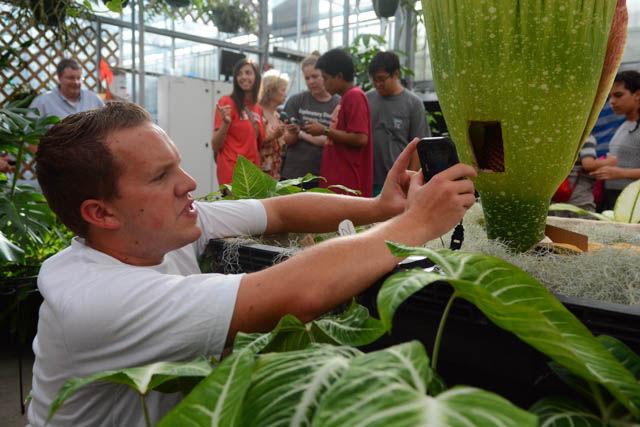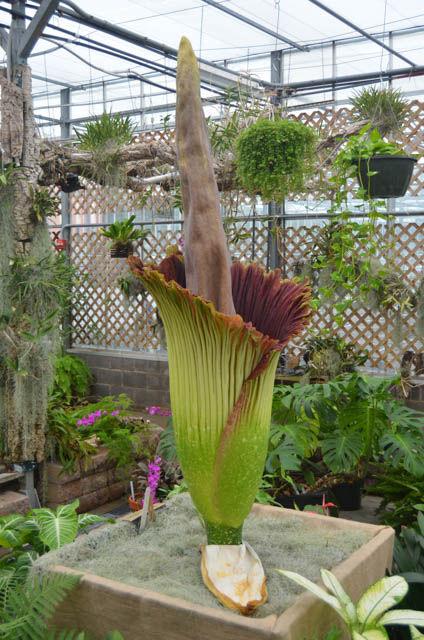In a row house in northeast Philadelphia with a mid-sized yard, a young boy frequented in the garden out back. Now, he is an enthusiastic plant collector with a rare plant, one of the largest flowers in the world.
Brandon Huber is a graduate student studying horticultural science, and this weekend his rare corpse flower bloomed for the first time on Thursday in the Marye Anne Fox Teaching Greenhouses.
“Generally they frown upon people bringing their pet plants to their greenhouse,” Huber said. “They don’t want everyone’s house plants in here because then it would be like a hoarder’s paradise in here. But something like this, [the conservatory curator] was like ‘absolutely.’”
The plant, which has been growing for 13 years, was 6 feet 4 inches tall before it bloomed.
“I’m going to need a third yardstick,” Huber said on Thursday, bouncing toward the plant he has cared for the past 10 years.
The corpse flower is the world’s largest species of flower, and it receives its name from the stench it releases when it blooms. The flower releases chemicals similar to those released by rotting flesh.
“I was coming around the corner, three greenhouse ranges back, and I could smell it all the way back there blowing out the exhaust fan,” Huber said. “And I knew that’s it; that’s my plant.”
Huber received the plant from Huntington Botanical Gardens in California, which was one of the first places in the U.S. to bloom a corpse flower.
Huber’s parents and older brother drove seven hours from Pennsylvania to see the flower.
“He just wanted one of these so bad, and he was so excited when he brought it home and started raising it,” said Ron Huber, Brandon’s father. “It’s like we came down and we’re having a grandchild. But all the work he put into this, we’re just proud of him.”
Brandon’s parents noted that his fascination with plants was deeply rooted in his childhood.
“It started as he was a toddler, he’d be out in the garden and he wanted to play in the garden with whatever he was growing — peppers, tomatoes,” said Judy Huber, Brandon’s mother. “He took over my garden at a very young age.”
Ron Huber reflects on his son’s ever-growing level of interest in plants.
“Every time when we went to flower shows people would ask us if we had a greenhouse and I’d go, ‘No, we have a green house,’” Ron Huber said. “It just infiltrated the whole house. We never had any plants of our own anymore because he just took over.”
In his childhood bedroom, grow lights sat beneath a lofted bed, illuminating a collection of cacti, Venus flytraps, pitcher plants and more.
“Anything unusual, he was always into the weird and unusual things,” Rob Huber said. “We’ve got palm trees and a banana tree in the backyard. He had a banana tree in his room for a while, a little one … We improvised, we made makeshift shelves for his plants, whatever he needed. They were all over his room as his collection grew.”
Today, Brandon lives in an apartment and could only bring a portion of his plants with him. However, that hasn’t halted his collection.
“Pretty much all plant collectors are like that, where they’ll grow pretty much as many plants as they possibly can,” Brandon Huber said. “Almost probably too many, but somehow we make it all work.”
When selecting his apartment, Brandon kept his plants in mind.
“I had a choice between taking a north-facing one, a south-facing one, and took the south-facing one because you get way better light,” Brandon Huber said. “And only a plant person would think of that.”
As for the future of the corpse plant, it is expected to produce 100-200 seeds, which Brandon will give to members of the plant breeding community.
Sam Messick contributed to the reporting of this story.
The titan arum, also known as the corpse flower, began to bloom on Thursday. The flower blooms every 10-13 years and as it does, it is said to smell like rotting flesh.









